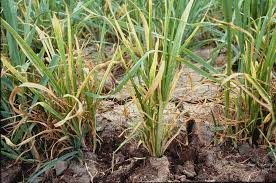Popular Herbicide Atrazine A Major American Health Risk
Video Link: https://vimeo.com/182244073
Video Download: Popular Herbicide Atrazine A Major American Health Risk
Video Stream: Popular Herbicide Atrazine A Major American Health Risk
The Dangers of Atrazine
Atrazine is a pesticide used across America that can potentially have serious health consequences for animals and people. Although Atrazine is banned as a pesticide in other areas of the world, Atrazine remains available in the United States for such purposes despite growing awareness and protests from consumers.
What is Atrazine?
Essentially, Atrazine is a weed killer used to prevent the invasion of weeds that inhibit the optimal growth of many crops, including sugar cane, sorghum, and corn. Outside of agriculture, Atrazine is frequently utilized to kill weeds on lawns and golf courses.
 Atrazine has been used in the United States since it was first introduced in 1959. It is synthesized primarily by a chemical manufacturer in Switzerland known as Syngenta. The entire EU banned Atrazine as a pesticide in 2004, although countries began banning the substance in 1991. Despite this, the United States still burns over eighty million pounds of Atrazine annually.
Atrazine has been used in the United States since it was first introduced in 1959. It is synthesized primarily by a chemical manufacturer in Switzerland known as Syngenta. The entire EU banned Atrazine as a pesticide in 2004, although countries began banning the substance in 1991. Despite this, the United States still burns over eighty million pounds of Atrazine annually.
Atrazine is Dangerous to the Animal Environment
Although Atrazine is highly effective as a weed killer, it also has a dangerous impact on animals in the local ecosystem, including humans. Atrazine is an endocrine disruptor, meaning it can interfere with the standard and healthy function of the endocrine system, which controls hormone balance.
This is especially apparent in amphibians like frogs, readily absorbing chemicals directly through their skin. Atrazine exposure actually causes male frogs to change sexes! This metamorphosis occurs at 2.5 per billion environmental levels, perhaps even lower! The Environmental Protection Agency considers three parts per billion to be ecologically safe, but this directly goes against clinical and field evidence.
This issue is so significant that scientists believe that exposure to Atrazine and similar chemicals is one of the primary reasons for the sharp decline in amphibians' global population. Today, one in every three amphibian species is at risk of extinction.
These health issues are also apparent in reptile and mammal species. Atrazine exposure has been linked to increased breast and prostate cancer incidence in rodents and reproductive problems in fish. The continuing study demonstrates that there are also potential issues for humans.
How May Atrazine be Dangerous to Humans?
As scientists move outside the laboratory and ecological environment and into the human sphere, they find increasingly strong correlations between Atrazine and human reproductive health, especially concerning human development in the womb.
Atrazine Exposure Causes Babies to Be Born Lighter
A study from the year 2009 shows that exposure to Atrazine from water directly impacts the birth weight of the child. Babies born underweight are at a significantly increased risk of several conditions, including diabetes and cardiovascular disease. And this is just due to exposure to Atrazine from the water supply!
Atrazine is Prevalent in the American Water Supply
Because of this study and others, voices of concern are growing louder regarding the restriction or outright ban of Atrazine as an herbicide. Atrazine is highly prevalent in the water table after decades of extensive use.
A study by the United States Geological Survey shows that forty percent of groundwater and seventy-five percent of flowing streams in agricultural zones are contaminated with Atrazine. Atrazine is even in most people's local drinking water! Researchers tested water from over 150 city waterworks and found that four out of every five were contaminated with Atrazine.
Atrazine Stays Active in the Environment Long After It Has Been Introduced
One thing that makes Atrazine worse than other similar herbicides is that it stays in the environment for an exceptionally long time. Atrazine was banned in France more than fifteen years ago, but it is still present at traceable levels even today.
Atrazine is a global health hazard because it gets absorbed with water into the clouds and actually falls back to earth. It is estimated that over 500,000 pounds of Atrazine enter the water cycle every year, leading to a more significant and pervasive effect on natural and artificial water supplies.
As recently as 2006, the Environmental Protection Agency considered Atrazine safe for agricultural use and maintained that it did not propose any risks to humans.
Many environmental lobbying groups, however, consider this decision a mistake and strongly feel that weak monitoring and poor regulations have caused Atrazine to enter drinking water and the water table at exceptionally high levels, which they think almost certainly puts some people at significant health risk.
Why is Atrazine So Popular?
There are many reasons why agricultural specialists are so fond of Atrazine. For one, it's cheaper than many other herbicides. Also, it doesn't negatively impact the crops themselves and increases the number of fruits and vegetables they have to sell.
In the end, it saves them a lot of money. A two-decade research study showed that Atrazine increased harvested crops per acre by more than 5.5 bushels, which was more than a five percent increase.
This increase in yield provided an average increased profit per acre of more than $25, which was concluded to equal an increase in revenue of almost $1.4 billion per year to American farmers. An EPA study provided similar results, concluding that farmers earned $1.5 billion more attributable to Atrazine.
Despite Its Benefits, Atrazine Can Easily Be Replaced
Even though Atrazine provides tremendous benefits to farmers, it would not hurt the bottom lines much to eliminate Atrazine due to its potential health hazard. USDA studies suggest that if Atrazine use were made illegal in America, corn production would only drop by around 1.2%, leading to about a  2.3% drop in corn planted nationwide.
2.3% drop in corn planted nationwide.
There is also evidence that these studies are flawed in their conclusions, as, after Atrazine was banned in Germany and Italy, neither nation suffered in terms of revenue as a result of the ban.
Because these two countries faced no issues resulting from the ban on Atrazine, there is no reason why Atrazine shouldn't be banned in the United States. Evidence even shows that Germany and Italy experienced larger national harvests without Atrazine.
The Risks Outweigh the Benefits: Ban Atrazine on American Crops
Most recent independent studies show that Atrazine likely only increases harvest by 1-2% at best. This, combined with the fact that the herbicide is highly detrimental to the environment while also imposing a threat upon human health, should lead most reasonable individuals to conclude that Atrazine should be banned in the United States as it is in Europe.
- 0001 What Is The Difference Between Health And Wellness? [Last Updated On: January 18th, 2025] [Originally Added On: November 26th, 2020]
- 0002 What Is Human Growth Hormone [Last Updated On: January 18th, 2025] [Originally Added On: November 27th, 2020]
- 0003 Types Of Psoriasis Treatment [Last Updated On: January 17th, 2025] [Originally Added On: November 28th, 2020]
- 0004 The Effects Of Elevated Homocysteine Levels On Health And Well Being [Last Updated On: January 16th, 2025] [Originally Added On: November 29th, 2020]
- 0005 Are Hgh Anti-aging Claims Legitimate? [Last Updated On: December 13th, 2025] [Originally Added On: November 30th, 2020]
- 0006 The Influence Of Patent Law On Generic And Patented Medications [Last Updated On: December 12th, 2025] [Originally Added On: December 2nd, 2020]
- 0007 How Does Hgh Keep You Young? [Last Updated On: December 10th, 2025] [Originally Added On: December 4th, 2020]
- 0008 Hgh Honesty A Hallmark Of Indians Pitcher Byrds First Book [Last Updated On: December 9th, 2025] [Originally Added On: December 5th, 2020]
- 0009 How Does Growth Hormone Deficiency Testing Work? [Last Updated On: December 8th, 2025] [Originally Added On: December 6th, 2020]
- 0010 Hgh Benefits [Last Updated On: December 6th, 2025] [Originally Added On: December 7th, 2020]
- 0011 Four Best Ways To Boost Hgh Levels [Last Updated On: February 17th, 2025] [Originally Added On: December 8th, 2020]
- 0012 Can Laughter Boost Hgh Production? [Last Updated On: February 19th, 2025] [Originally Added On: December 9th, 2020]
- 0013 Can Hgh Reverse The Damage Of Drug Addiction? [Last Updated On: December 3rd, 2025] [Originally Added On: December 10th, 2020]
- 0014 Bio-identical Hgh And Testosterone For Andropause [Last Updated On: December 2nd, 2025] [Originally Added On: December 11th, 2020]
- 0015 Lifting Weights Increases Growth Hormone and Testosterone! [Last Updated On: February 16th, 2025] [Originally Added On: June 26th, 2021]
- 0016 How Can I Check Out the Credentials of a Physician Before Getting HRT? [Last Updated On: March 8th, 2025] [Originally Added On: February 1st, 2023]
- 0017 What is the Age Profile of Adult-Onset HGH Sufferers? [Last Updated On: May 1st, 2025] [Originally Added On: June 4th, 2023]
- 0018 Introduction: Importance of Checking a Physician's Credentials [Last Updated On: March 4th, 2025] [Originally Added On: March 4th, 2025]
Word Count: 1054






